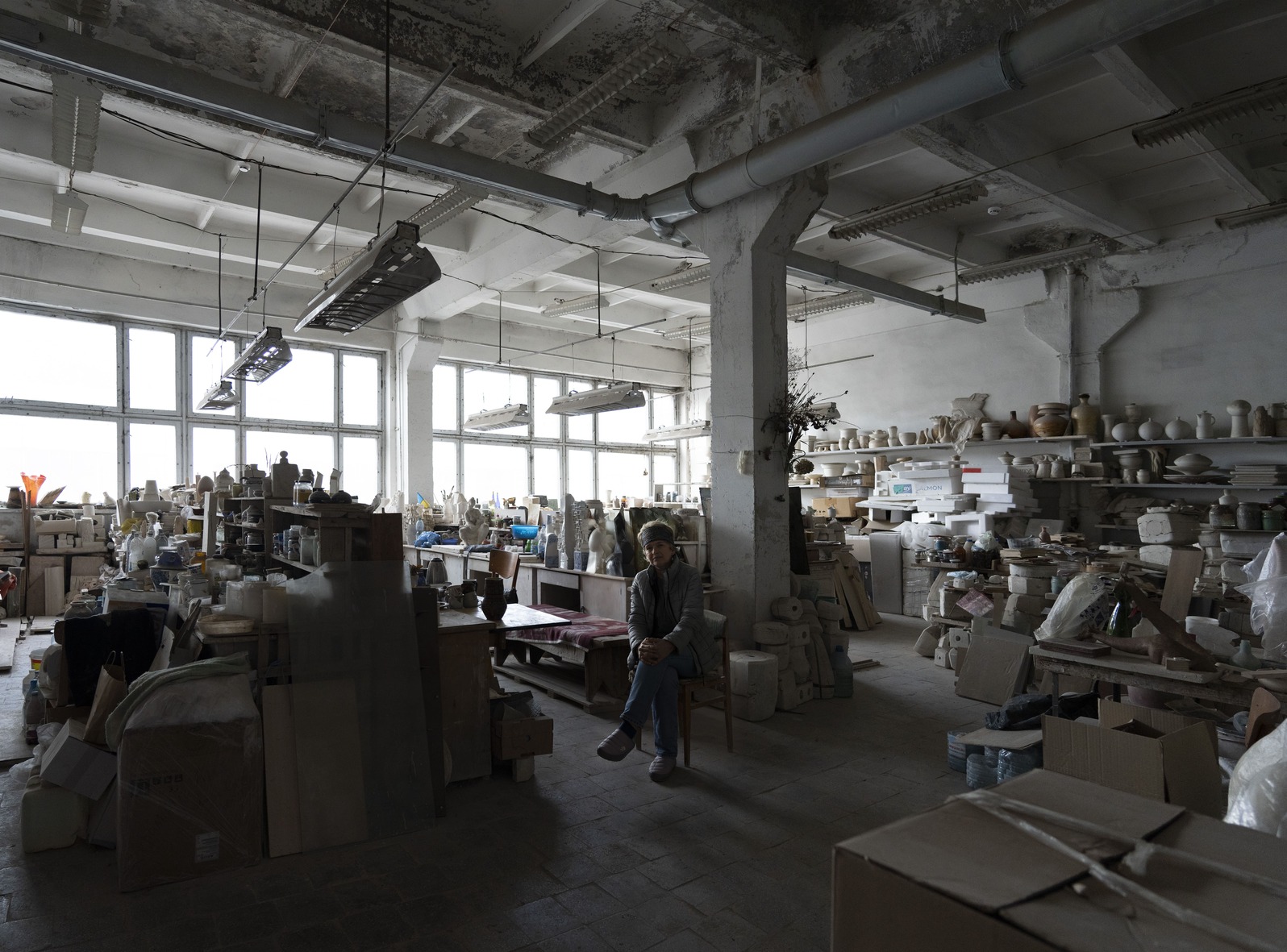Ганна Друль
Hanna Drul
«Українські жінки – “зарадні”. У цьому слові стійкість, гнучкість, здатність витримувати негаразди та бути підтримкою іншим. Такий досвід вкорінений глибоко, ще з козацьких часів».

З серії «Before the Future», 2025
Друк на Hahnemuhle Photo Rag Metallic, Dibond
Повномасштабна війна була для мисткині шоком не лише на фізичному, а й на глибинному, екзистенційному рівні. Здавалося, що йдеться не просто про спробу захоплення території, а про намір стерти культуру, знищити ідентичність, знівелювати саме існування українського народу.
У перші місяці вона втратила здатність творити, мистецтво здавалося недоречним, мовчазним перед лицем трагедії. Внутрішня ініціатива згасла, і життя на деякий час перетворилося на виживання. Щоб упоратися зі стресом, довелося вдатися до медикаментозної підтримки. Але саме волонтерська діяльність і фізична праця повернули відчуття корисності та дали сили.
У той самий період з’явилося гнітюче переконання: наче мистецтво більше не має ваги. Усе довкола трималося на плечах військових, лікарів, волонтерів, а художники опинилися на периферії сенсів. Виникали сумніви, чи припустимо творити, коли триває знищення цілого народу? Але поступово прийшло усвідомлення: саме через мистецтво можна зберегти внутрішній зв’язок із життям.
Творчість поступово повернулася, але вже в іншій ролі – як внутрішній вибір залишатися. Це не був раціональний процес, швидше імпульс самозбереження. У моменти фізичної слабкості мистецтво не зникало, а набувало нової форми, ставало тихим, але стійким духовним спротивом. Тепер воно було не лише про ідеї, а про сам факт існування. Бо коли твориш – ти існуєш. І твій дух незнищенний.
Першою роботою цього періоду стала скульптура «Юдит» – біблійний образ, перетлумачений у воєнному контексті. Червона постать, що тримає відрубану голову, стала символом виживання. Проєкт було реалізовано у США та в Україні.
Зі зміною внутрішнього ландшафту трансформувалася й ідентичність. Роль жінки більше не зводиться лише до підтримки, вона стає політичною. Тримати дім, берегти зв’язки, створювати простір для життя – усе це перетворюється на фундамент спільного спротиву. У той час, коли багато чоловіків мобілізовані, саме жінки взяли на себе відповідальність за тяглість. Побутову, емоційну, культурну. Вони не лише зберігають, а й формують спільноту.
Це не нове. Українські жінки – «зарадні». У цьому слові стійкість, гнучкість, здатність витримувати негаразди та бути підтримкою іншим. Такий досвід вкорінений глибоко, ще з козацьких часів. І хоч це не завжди справедливо і далеко не легко, саме завдяки цій особливості вдавалося виживати.
Паралельно художниця критикує поділ мистецтва на «жіноче» та «чоловіче», підкреслюючи цілісність мистецького висловлювання. Для неї творчість – це не гендер, не жанр і не привілей. Зараз – це форма існування. В часі, коли саме існування опиняється під загрозою.
‘Ukrainian women are zaradni. This word carries resilience, flexibility, the ability to endure hardship, and support others. It’s a legacy rooted deeply — stretching back to Cossack times.’
For Hanna Drul, the full-scale invasion was a shock not only physically but on a profound existential level. It seemed to her not merely a war for territory but an attempt to erase culture, destroy identity, and nullify the very existence of the Ukrainian people.
In the first months, she lost the ability to create. Art felt inappropriate — silent in the face of catastrophe. Her inner momentum dimmed, and life for a time became pure survival. To cope with the stress, she turned to medication. But it was volunteering and physical labour that helped restore a sense of usefulness and strength.
At that time, a heavy thought took root: that art no longer had weight. Everything seemed to rest on the shoulders of soldiers, medics, and volunteers, while artists felt themselves at the periphery of meaning. She doubted whether it was even acceptable to create while the annihilation of an entire nation was underway. But gradually came the understanding that art could preserve her inner connection to life.
Creativity returned — but with a different role. It was no longer a profession or external expression. It became an internal decision to stay. Not a rational process, but a pulse of self-preservation. In moments of physical weakness, art did not disappear — it changed form, becoming a quiet but enduring spiritual resistance. It was no longer about ideas but about existence itself, for when you create, you exist. And your spirit cannot be destroyed.
The first work she made during this period was the sculpture Judith — a biblical figure reimagined in the context of war. A red figure holding a severed head became a symbol of survival. The project was realized in both the United States and Ukraine.
As her inner landscape changed, so did her identity. The role of the woman no longer revolved solely around care — it became political. Holding a household, preserving ties, creating a space for life — these became foundational acts of collective resistance. In a time when many men are mobilised, it is women who have taken on the continuity — domestic, emotional, cultural. They are not only preserving; they are shaping the community.
But this is nothing new. Ukrainian women are zaradni — a word that defies direct translation but conveys the ability to manage, adapt, and sustain. It expresses stamina, intuition, and capability. This way of being is deeply rooted, going back to the times of the Cossacks. And though it is not always fair, and never easy, it is precisely this quality that has made survival possible.
In parallel, Hanna questions the division of art into ‘female’ and ‘male’. For her, artistic expression is not about gender, genre, or privilege. Right now, it is a form of being in a time when existence itself is under threat.